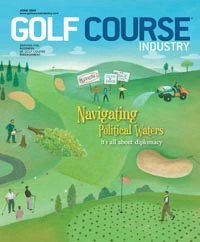The golf season is in full swing, and televised events have been broadcast weekly since January. For professional golfers, every shot counts, and millions of dollars are at stake. Decisions and disputes about the Rules of Golf are handled by qualified officials using Decisions on the Rules of Golf.
There are numerous rules-related details golf course superintendents must attend to when preparing for tournaments or daily play. Consider the following.
Putting greens
There’s a single Rule (16) for the putting green. Keep these decisions in mind when placing the final touches on the putting greens:
- 16/4 – A hole liner must be sunk deep enough. When setting the hole liner into the green, it should be at least one inch below the surface of the turf. If it’s not, there can be added rules issues such as a ball striking the edge and bouncing out of the hole or the ball striking the hole liner when the flagstick is being removed from the hole.
- 16-1a/6 – If a hole liner isn’t set correctly and the dimensions of the hole become damaged, the hole might need to be changed, delaying play. This isn’t ideal once you’ve headed home or returned to the maintenance area while the event is under way.
- 16-1c – This part of the Rule allows for the repair of hole plugs, ball marks and other damage, whereby a competitor may repair a high or low hole plug, ball marks and even a spike mark if it’s within the hole plug, ball mark or other damage. An easy-to-remember adage in reference to hole plugs: “When they’re high, they die, and when they’re low, they show.”
Teeing ground
Several items should be considered when preparing teeing grounds:
- Avoid stretching the yardages on golf holes by placing the tee markers a few feet from the back edge of the tee. This doesn’t meet the two club lengths required to meet the definition and shortchanges the player’s stance if one foot is off the back in the rough.
- There should be no surrounding obstructions or other plant growth compromising the setup of the teeing ground.
- Incorrect tee marker alignment can cause player and Rules issues such as play outside the teeing ground, out-of bounds concerns (Rule 27) or a missing tee marker where a player would need to estimate the area for play.
- Teeing grounds should be smooth, level and firm.
- Always consider left-handed players.
Bunkers
Unfortunately, bunkers have become a favorite place to be, but fundamentally, it’s wrong if you’re spending more time and money on sand than turf.
- When using a mechanical bunker rake, don’t leave any ridge or raised sand bank where a player could touch the sand during his backswing (13-4/31), causing a penalty for testing the condition of the hazard.
- If the wind picks up during an event, remove any debris, such as leaves, twigs or grass, which fall into the bunker. If a player touches any debris, he receives a penalty, according to 13-4/33.
- Ensure there’s no functioning drainage within the bunker. If, during or following a heavy downpour, pumping water is required, then 25-1b/8 will cover the options for the player.
- To meet tournament-level expectations of bunker preparation, the hazard must have a clearly defined margin. No rocks or stones should be within the hazard, and sand should be the proper depth.
- Miscellaneous decision (Misc./2) suggests bunker rakes should be left outside bunkers in areas where they’re least likely to affect ball movement.
Miscellaneous preparation decisions
- If you have a problem with fire ants, Rule 33 and its decision 33-8/22 allow you to treat ant hills as ground under repair, and the appropriate relief would follow.
- If your staff misses a pile of clippings, then decision 25/11 indicates the clippings are loose impediments, whether or not they’re piled for removal, and may be removed by the player – then Rule 23-1 (revised).
- The Tournament Players Championship, which was contested in May at Ponte Vedra, allows for the marking of the famous island green (17th hole, par 3) under decision 33-2a/10. The committee may mark the water behind the hole a lateral water hazard for daily play. For the championship, they may mark it as a regular water hazard and establish a dropping zone, giving the player whose ball is in the hazard an option for where to play his next stroke.
- Finally, for those who chew tobacco and occasionally miss the target, Rule 25 and decision 25/6 provides the status of saliva, and in equity (Rule 1-4), saliva can be treated as an abnormal ground condition (Rule 25-1) or as a loose impediment (Rule 23-1) at the player’s option. It’s nasty, but it’s the rules. GCI
Tim Moraghan is principal of Aspire Golf Consulting in Long Valley, N.J. He can be reached at tmoraghan11@comcast.net or 908-635-7978.

Explore the June 2008 Issue
Check out more from this issue and find your next story to read.
Latest from Golf Course Industry
- Heritage Golf Group acquires North Carolina courses
- Editor’s notebook: Green Start Academy 2024
- USGA focuses on inclusion, sustainability in 2024
- Greens with Envy 65: Carolina on our mind
- Five Iron Golf expands into Minnesota
- Global sports group 54 invests in Turfgrass
- Hawaii's Mauna Kea Golf Course announces reopening
- Georgia GCSA honors superintendent of the year





